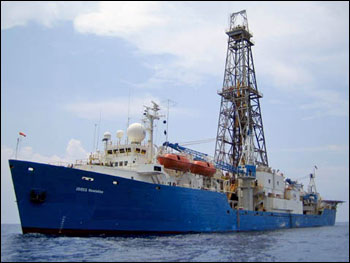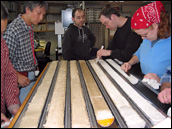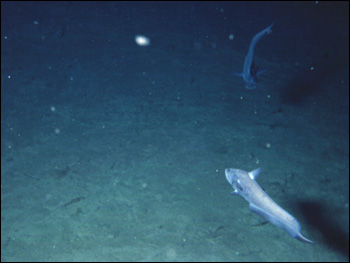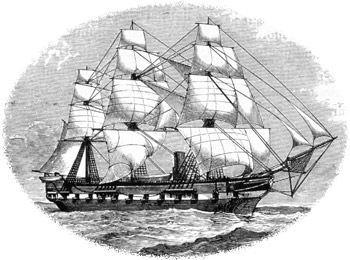

|
by Holli Riebeek · design by Robert Simmon · September 27, 2005 Clad in a hard hat and steel-toe boots, paleoceanographer Jerry McManus strides onto the deck of the JOIDES Resolution, staring through the steel rigging that supports the ship’s drilling equipment at the brilliant star-studded sky. Here, in the middle of the ocean, city lights do not dim the night sky, and the clear view is spectacular. McManus, an associate scientist at the Woods Hole Oceanographic Institution, has just completed another 12-hour shift in one of the ship’s six science labs, where he has been analyzing samples of the sea floor to glean bits of evidence about past climates. |
| ||
 |
The JOIDES Resolution cruises the globe sampling sediments from the bottom of the world’s oceans. The ship is capable of drilling holes over 2,100 meters (6,890 feet) below the sea floor in water up to 8,000 meters (26,000 feet) deep. (Photograph courtesy JOI Alliance/IODP) | ||
Even now, in the dead of the night, it is not quiet. The ship’s twelve powerful thrusters whine constantly as their 750-horsepower engines struggle against the ocean currents to keep the ship in one place while the drilling crew pulls long sections of mud from the sea floor. The science labs continue to bustle as another crew replaces those who are leaving for the night, and caterers and housekeepers move through the ship to support the science and drilling teams. McManus pauses to scan the surface of the ocean for signs of whales or other sea life. He saw a manta ray jumping once, but not tonight. He returns to his room in the forecastle deck. Two sets of bunk beds accommodate the four people who share the room, but he rarely sees his roommates. They are on other shifts in this all-too-brief voyage to coax climate secrets out of the ocean depths. |

Researchers study a freshly recovered sediment core inside one of the science labs on board the Resolution. (Photograph courtesy JOI Alliance/IODP) | ||

Year after year, a steady rain of dust, plants, and animal skeletons settles on the ocean floor. As new materials pile on top of old materials, layers of sediment form a vertical timeline extending millions of years into the past. McManus and his colleagues on the Resolution are drilling long cores of the ocean floor to read the timeline. The 470-foot-long research vessel is specially equipped to pull cores of mud from the sea floor. Much of equipment, and the ship itself, is adapted from tools the oil industry uses to drill at sea, and, as a result, the Resolution resembles an oil rig with its steel drill tower and deck-top cranes. |
Over thousands and then millions of years, the sea floor becomes covered in a thick layer of sediment. Plants and animals living in the ocean above die and decay, contributing their skeletons along with dust, volcanic ash, and other inorganic material. Scientists use the accumulated material as a timeline to study past climate. (Photograph copyright Woods Hole Ocean and Climate Change Institute) | ||
In the center of the ship, long sections of pipe snake down to the sea floor where a drill is fitted on the outside of the pipe. A solid piston inside the pipe moves up as the pipe plunges into the mud so that the pipe fills with mud as it sinks. The goal is to pull up a column of sediment without disturbing it. Stirring the sediment would destroy the timeline preserved in the layers. The pipe draws up 10-meter segments of earth at a time. A cone with a homing device rests over the drill hole so the pipe can be lowered into the same location to retrieve the next 10 meters until the drill hits the solid rock of the sea floor. The Resolution is perhaps the most advanced scientific ocean drilling ship, and an international consortium of ocean researchers called the International Ocean Drilling Program is responsible for it. Though the technology is vastly different, the idea of a science-dedicated ocean exploring vessel isn’t too far off from the first explorations in the 1870s. On December 21, 1872, a three-masted, square-rigged wooden ship set sail from Portsmouth, England, to start a three-and-a-half-year voyage that would take the HMS Challenger from the North Atlantic to Antarctica and around the world. The ship’s crew and teams of physicists, biologists, and chemists from around the world sounded out the depths of the ocean, collected samples of plants and animals and ocean water, and recorded sea temperature at various depths. They published their results in a 50-volume report, each volume containing 29,500 pages. The voyage of the Challenger became the basis of modern oceanography. Scientists on the Challenger dredged the ocean floor with large bags to collect plant and animal samples. They found that the ocean was covered in fine sediment that contained the fossils of sea animals. What was more, the fossils were different in cold areas verses warm areas. The finding thrilled paleoclimatologists, who wanted to use the fossils to determine how cold the oceans had been in the past. Scientists almost immediately began to devise systems of hollow pipes that could be used to bring a column of the sea floor to the surface. |

Drilling on board the Resolution continues day and night. From top to bottom: drilling derrick, drill bit, re-entry cone, and a retrieved core. (Photographs courtesy JOI Alliance/IODP) | ||

These records from the deep yielded many important insights to the Earth’s past climates. Each layer within the core holds fossils of the tiny plants and animals that dominate the ocean, as well as grains of dust and minerals that can tell about wind and current patterns. Like land fossils, marine fossils offer clues about conditions in the ocean when the plant or animal lived. The cores are carefully labeled (“this way up” is a crucial designation for the vertical time lines) and divided into smaller sections for analysis. |
The 19th-century voyage of the HMS Challenger set the standard for subsequent ocean research vessels. Among other discoveries, scientists on the Challenger realized that fossils retrieved from samples dredged from the sea floor revealed past climates. (Image courtesy NOAA Photo Library) | ||